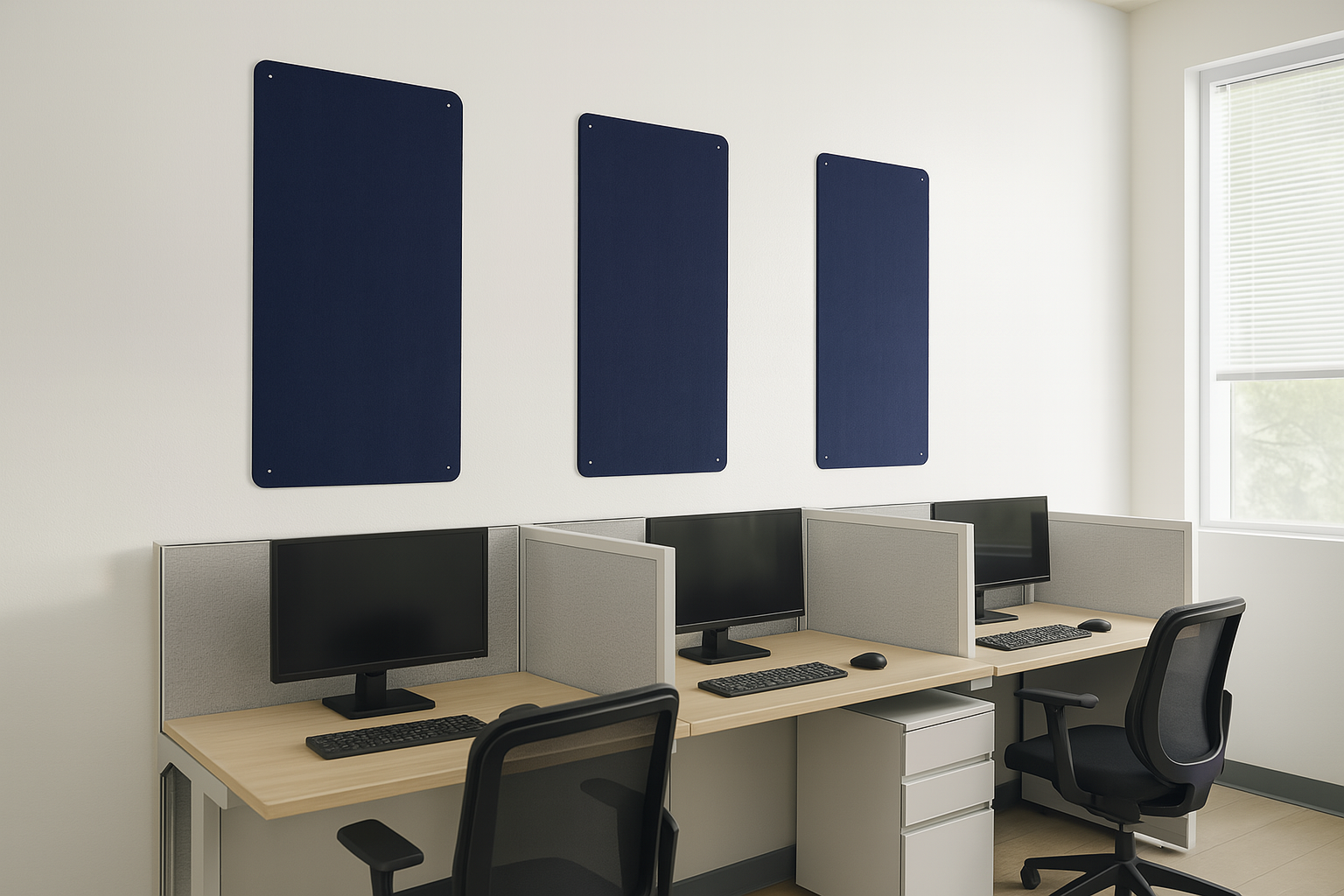The Link Between Call Center Noise and Agent Burnout
Posted by Kate Murphy on Jul 18th 2025
“Your call is important to us. So is keeping your sanity.”
Call centers are noisy. That’s just part of the job—until the noise starts adding to the stress.
The high-pressure call center environment is built on conversation, but when background noise accumulates, it becomes more than just a nuisance. It becomes a fast track to burnout. This article unpacks how acoustic overload wears call center teams down—and how Versare can help dial the volume (and the stress) back.

What Is Call Center Burnout?
Call center burnout is a reality many agents face as they navigate high workloads, tight schedules, and demanding customer interactions. It’s a persistent, chronic state of physical, emotional, and mental exhaustion caused by ongoing workplace stress.
Burnout, as defined by the World Health Organization (WHO), is a “syndrome conceptualized as resulting from chronic workplace stress that has not been successfully managed.” The organization describes its three key symptoms:
- Feeling drained or exhausted
- Feeling disconnected from your job, or becoming negative and cynical about it
- Feeling like you’re not doing your job as well as you used to
Call center stress often comes from a few key sources. High call volume means agents face constant interruptions and the pressure to keep calls short, no matter how complex the issue. On top of that, low autonomy—like strict scripts, rigid performance metrics, and minimal decision-making freedom—can leave employees feeling stuck, strained, and on autopilot. And with limited breaks between draining calls, there’s often not enough time to reset before the next customer rings in.
These issues create the perfect storm for burnout—and noise makes it worse.
The Stressors of Call Center Noise
Common sources of disruptive call center sound include chatter from neighboring agents, echo and reverberation from hard surfaces and large open layouts, and electronic and mechanical interference (think ringing phones, printers, HVAC systems, keyboard clatter, and more).
While these sounds may seem like minor, everyday distractions, their cumulative impact on the brain is anything but small. Even when trying to tune out the noise, the brain still reacts. Prolonged exposure to ambient noise can impair working memory, making it harder for agents to retain information. It also increases the risk of simple mistakes as focus wears down. On top of that, constant background noise triggers the body’s stress response, creating a cycle of mental fatigue and irritability.
Psychological Effects of Acoustic Overload
Workplace noise isn’t just annoying, it’s a proven stress trigger. A review published in Noise & Vibration Worldwide found that both short- and long-term exposure to loud environments significantly raises cortisol levels, the body’s primary stress hormone. This hormonal spike disrupts sleep, impairs focus, and increases the risk of burnout.
The effects don’t stop there. A study in Oxidative Medicine and Cellular Longevity shows that chronic noise also elevates blood pressure and heart rate, increasing the risk of serious health issues like stroke, heart disease, and hypertension. On the mental health side, long-term noise exposure has been linked to higher rates of anxiety, depression, and unhealthy coping habits.
Even everyday office noise takes a toll. Another study found office noise makes it harder to concentrate. The biggest offenders? Ringing phones and background conversations—core parts of the call center environment. Constant noise fuels frustration, drains mental energy, and ultimately pushes employees toward disengagement.
Productivity, Turnover, and the Cost of Inaction
Relentless call center stress leads to increased absenteeism, more errors on the job, and declining customer satisfaction, creating a ripple effect that impacts both employees and clients. Thus, burnout is likely the main driver of contact centers’ astonishingly high turnover rates, averaging 30-45% annually, with some sectors reaching 60%.
This high turnover comes at a steep price. It sets off a costly chain reaction that goes well beyond just recruitment expenses. Every agent who leaves takes valuable knowledge, training investments, and established customer relationships with them. This makes the financial impact significant—replacing a single agent can cost between $10,000 and $20,000 when you factor in recruiting, training, and lost productivity.
Ignoring the stress and burnout in call centers doesn’t just hurt employees—it undermines long-term team stability, leading to constant churn, lost expertise, and declining morale. That makes it even harder to maintain high-quality service and keep operations running smoothly.
Acoustic Solutions to Combat Burnout
The good news? Acoustic intervention works—and it’s easier than you might think. Versare offers a full suite of solutions designed specifically for busy, high-volume call center environments.
- Room Dividers: Create modular, private zones that absorb sound and minimize visual distractions. With multiple sizes and configurations, these partitions offer both auditory privacy and visual separation—helping agents stay focused without constant interruptions.
- Acoustic Panels: Wall-mounted, ceiling, and desktop acoustic panels trap and diffuse unwanted noise. Wall panels quiet large, shared spaces, ceiling baffles absorb overhead echo, and desktop panels create focused, semi-private workstations.
- Freestanding Acoustic Panels: Unlike permanent walls, freestanding acoustic panels give you the freedom to adapt your space on the fly—no costly renovations, no permanent construction, just simple, flexible control over your call center environment.
Plus, when you see the name SoundSorb™ in a product, you know you're getting Versare’s top-tier acoustic performance. SoundSorb™ panels are built into many sound-dampening solutions and are made from eco-friendly, recycled materials. They’re lightweight yet highly effective—with Noise Reduction Coefficients (NRC) rated up to 0.77. That means they capture up to 77% of ambient sound, helping reduce echoes and background chatter. The result? A quieter, calmer environment where teams can focus, recharge, and communicate without distraction—all while maintaining a clean, modern aesthetic.
Tips for Implementing an Acoustic Strategy
Creating a quieter, more focused call center environment doesn’t have to be complicated—but it does require a thoughtful approach. Here’s how to make the most of your acoustic improvements:
- Assess Current Noise Levels
Start by getting a clear picture of where noise is coming from and how it’s affecting your team. Use decibel meters and employee surveys to pinpoint the loudest hotspots and understand when distractions peak.
- Listen to Your Agents
Your frontline staff know where the biggest noise challenges are. Ask for their input so you can prioritize solutions that actually help.
- Prioritize High-Traffic Areas
Focus your acoustic upgrades on the noisiest zones first. Supervisor stations, training pods, and open collaboration spaces often generate the most background chatter.
- Design Without Disruption
Acoustic improvements shouldn’t halt daily operations or require expensive renovations. Versare’s modular, toolless solutions are mobile and flexible, allowing you to redesign your workspace without downtime, permits, or construction crews.
- Monitor and Adjust
An effective acoustic strategy isn’t one-and-done. Continue to monitor noise levels and check in with your team after changes are made. As your team grows or shifts, reposition panels as needed to keep the environment optimized.
Building a Burnout-Resistant Call Center Culture
Acoustic panels and room dividers are part of the solution—but they work best when paired with a people-first culture.
Encourage regular breaks so agents can reset. Offer flexible scheduling when possible to support a healthier work-life balance. And most importantly, foster open communication about daily stressors and invite your team to share ideas for improvement. When employees feel heard and supported, a quieter workspace isn’t just about comfort—it becomes the foundation for calmer, more empathetic service.
Silence Is More Than Golden, It’s Strategic
Call center burnout won’t fix itself, but operations managers who are ready to lessen the noise can help their teams thrive. Reducing noise means boosting employee well-being, sharpening productivity, delighting customers, and cutting down costly errors and turnover. Acoustic design isn’t just about aesthetics—it’s a smart investment in creating a work environment that truly works.
Ready to lower the noise and raise your team’s game? Explore Versare’s full line of acoustic panels and room dividers today.


